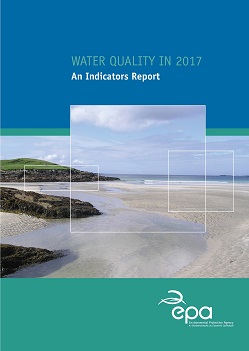Water Quality in 2017: an indicators report
Summary: These water quality indicators present the current situation, an indication of recent change and, where possible, longer term trends. These trends provide information on the improvement or deterioration in aspects of water quality and help us decide what actions to take to protect and improve water quality. The indicators have been set out in a ‘stand-alone’ fashion so that a concise assessment is available for each.

Environmental indicators represent a significant aspect of the state of the environment and related human activities. Indicators focus on:
• trends in environmental changes,
• the stresses causing them,
• how the environment and its components respond to these changes, and
• societal response to prevent, reduce or ameliorate these stresses.
Indicators typically make complex phenomena easier to understand. This improves communication to decision makers and makes it easier to measure progress towards established goals.
This report is an update to Water Quality in 2016: An Indicators Report;1 it will focus on the same 16 indicators and provide an update on any changes.
16 indicators
There are 16 indicators in this report. Each indicator summarises a particular water quality parameter or issue. These indicators tell the story of the state of Ireland’s aquatic environment. They look at the remote upland areas where many of our wide, meandering rivers begin, and at our abundant lakes and hidden groundwaters. They follow the estuaries that spill out into our coastal areas, and the beaches we treasure for their cleanliness and beauty.
The indicators present the current situation, an indication of recent change and, where possible, longer term trends. These trends provide information on the improvement or deterioration in aspects of water quality and help us decide what actions to take to protect and improve water quality. The indicators have been set out in a ‘stand-alone’ fashion so that a concise assessment is available for each.
The Indicators
We selected these indicators based on their scientific value, ease of detection and relevance to policy implementation, both nationally and internationally, in the context of the EPA’s existing core set of environmental indicators and following a review of other relevant water quality indicator sets maintained by the European Environment Agency. We also considered the indicators being developed to track progress in the implementation of the United Nations Sustainable Development Goals;3 these goals aim to promote prosperity while protecting the planet and are aimed at all countries. One of the relevant goals is Goal 6: clean water and sanitation.
The 16 indicators are:
1: River quality
2: High-quality river sites
3: Nitrate in rivers
4: Phosphate in rivers
5: Canal quality
6: Lake biological quality
7: Total phosphorus in lakes
8: Fish kills
9: Trophic status of estuaries and coastal waters
10: Nitrogen in estuaries and coastal waters
11: Phosphorus in estuaries and coastal waters
12: Nutrient inputs to the marine environment
13: Nitrate in groundwater
14: Phosphate in groundwater
15: Bacteria in groundwater
16: Bathing water quality
https://www.epa.ie/media/epa-2020/monitoring-amp-assessment/freshwater-amp-marine/Cover---JPEG---from-Water-Quality-in-2017---An-Indicators-Report_v4_COVER.jpg